Overview
In this article, we explore nine compassionate strategies designed to enhance emotional regulation in children with autism. We focus on techniques such as teaching emotional identification, establishing predictable routines, and incorporating mindfulness practices. These insights are grounded in research and expert perspectives, underscoring the significance of personalized approaches and ongoing assessments. By nurturing emotional awareness and resilience, we can make a meaningful impact on the lives of children on the autism spectrum.
As parents, understanding and addressing the emotional needs of your child can be challenging. Each strategy we discuss offers practical ways to support your child’s emotional journey. For instance, teaching emotional identification helps children recognize and articulate their feelings, fostering a sense of control and understanding.
Establishing predictable routines creates a comforting structure, allowing children to feel secure and less anxious. Additionally, incorporating mindfulness practices can help children become more aware of their emotions and learn to manage them effectively.
We encourage you to reflect on these strategies and consider how they can be integrated into your daily life. Your experiences and insights are invaluable, and we invite you to share them in the comments or through our newsletter. Together, we can build a supportive community that champions emotional growth and resilience for all children on the autism spectrum.
Introduction
In the realm of autism support, emotional regulation serves as a cornerstone for fostering well-being and resilience in children. As caregivers and professionals navigate the complexities of autism spectrum disorders, understanding and implementing effective strategies becomes essential.
Imagine teaching children to:
- Identify their emotions
- Establish predictable routines
- Incorporate mindfulness and sensory processing techniques
This multifaceted approach can significantly enhance emotional stability.
Recognizing the unique challenges faced by children with autism and adapting interventions accordingly empowers caregivers to help these children manage their emotions more effectively. This leads to improved social interactions and an overall better quality of life.
This article explores various strategies that not only support emotional regulation but also promote a collaborative environment among caregivers and professionals. Together, we can unlock the potential of every child on the spectrum.
About ASD Media: Comprehensive Resources for Autism Emotional Regulation
At ASD Media, we are deeply committed to advancing the application of ABA therapy, providing a wealth of resources aimed at enhancing autism emotional regulation for youth with developmental disorders. Our platform offers valuable insights, effective approaches, and a supportive community, empowering parents and professionals to navigate the complexities of autism emotional regulation with confidence.
Recognizing that the average cost of therapeutic behavioral services in the U.S. is $175.44, we understand the financial challenges parents often encounter when seeking support. By signing up for our newsletter, you can stay informed about the latest news and resources specifically designed to bolster mental health in youth with ADHD.
Moreover, we acknowledge that individuals on the spectrum are frequently vulnerable to bullying. Our resources directly address these concerns, promoting community initiatives that enhance autism emotional regulation techniques. This commitment to community support and collaboration is essential for unlocking the potential of youth with ASD, particularly in diverse communities facing disparities in resource access. This is a pressing issue highlighted by Yolande Loftus's research on the occurrence of ASD among different ethnic groups.
Together, we can create a nurturing environment that fosters understanding and support for all families. We invite you to join our community and share your experiences, as your voice matters in this journey.
Teach Emotional Identification: A Key Strategy for Autism Emotional Regulation
Helping children recognize their feelings is an essential step in improving mood regulation, particularly for those facing challenges with autism emotional regulation. Visual aids, such as emotion charts and flashcards, play a significant role in assisting kids to accurately label their emotions. Recent studies underscore the effectiveness of these tools, revealing that children who engage with visual aids show improved social literacy and recognition skills. For instance, a recent game’s second level emphasizes recognizing surprise, fear, and disgust—specific emotions that can be taught.
Engaging activities that promote discussions about feelings, like storytelling and role-playing, further bolster children's understanding and application of emotional concepts. As one expert wisely stated, "Teaching kids to recognize their feelings is a crucial step in their mental and social development." By nurturing an environment where children can identify and express their emotions, they become better equipped to develop personalized coping strategies that support autism emotional regulation. This supportive approach not only aids their psychological growth but also complements traditional therapies, leading to more effective outcomes in social interactions and overall well-being.
However, it's important to recognize the limitations of current research, as noted in studies that advocate for further exploration of emotional tacts and their generalization in natural settings. Creating a supportive learning environment, as highlighted in recent discussions, is vital for successfully implementing these strategies. Together, we can foster emotional awareness in our children, paving the way for their brighter futures.
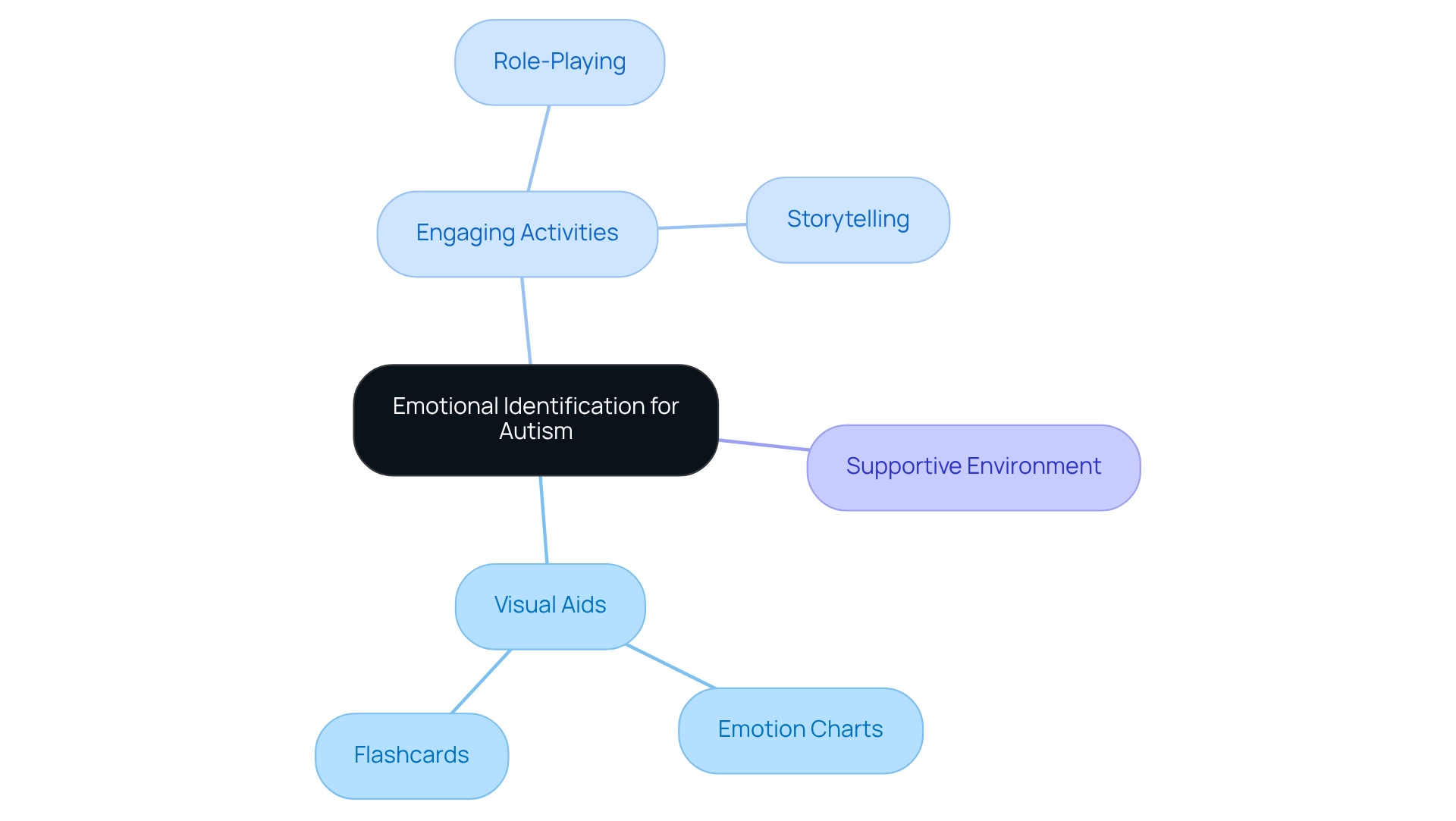
Establish Predictable Routines: Enhancing Emotional Stability in Autism
Creating consistent routines is vital for our young ones with developmental disorders, as it fosters a sense of safety and alleviates stress, which is essential for autism emotional regulation. Did you know that 50% to 80% of individuals with autism face sleep disorders? This statistic highlights the critical need for consistent daily schedules to bolster autism emotional regulation and enhance emotional stability. As parents, you can craft visual schedules that clearly outline daily activities, helping your children anticipate transitions and prepare for changes. For example, color-coded charts can make it easier for young individuals to identify different segments of their day. This predictability not only leads to improved emotional responses, enhancing autism emotional regulation, but also empowers them to navigate their day with greater confidence.
A compelling case study on neurodiversity emphasizes the importance of viewing structured routines as unique strengths. It advocates for strategies that support this perspective. As ASD Media wisely notes, 'Routines are not fixed; they should be frequently assessed and modified according to the feedback and developmental changes of the young individual.' This flexibility ensures that routines remain relevant and effective, ultimately supporting the psychological well-being of youngsters with developmental disorders and enhancing autism emotional regulation. So, let's embrace these strategies together and nurture our children's growth and happiness.
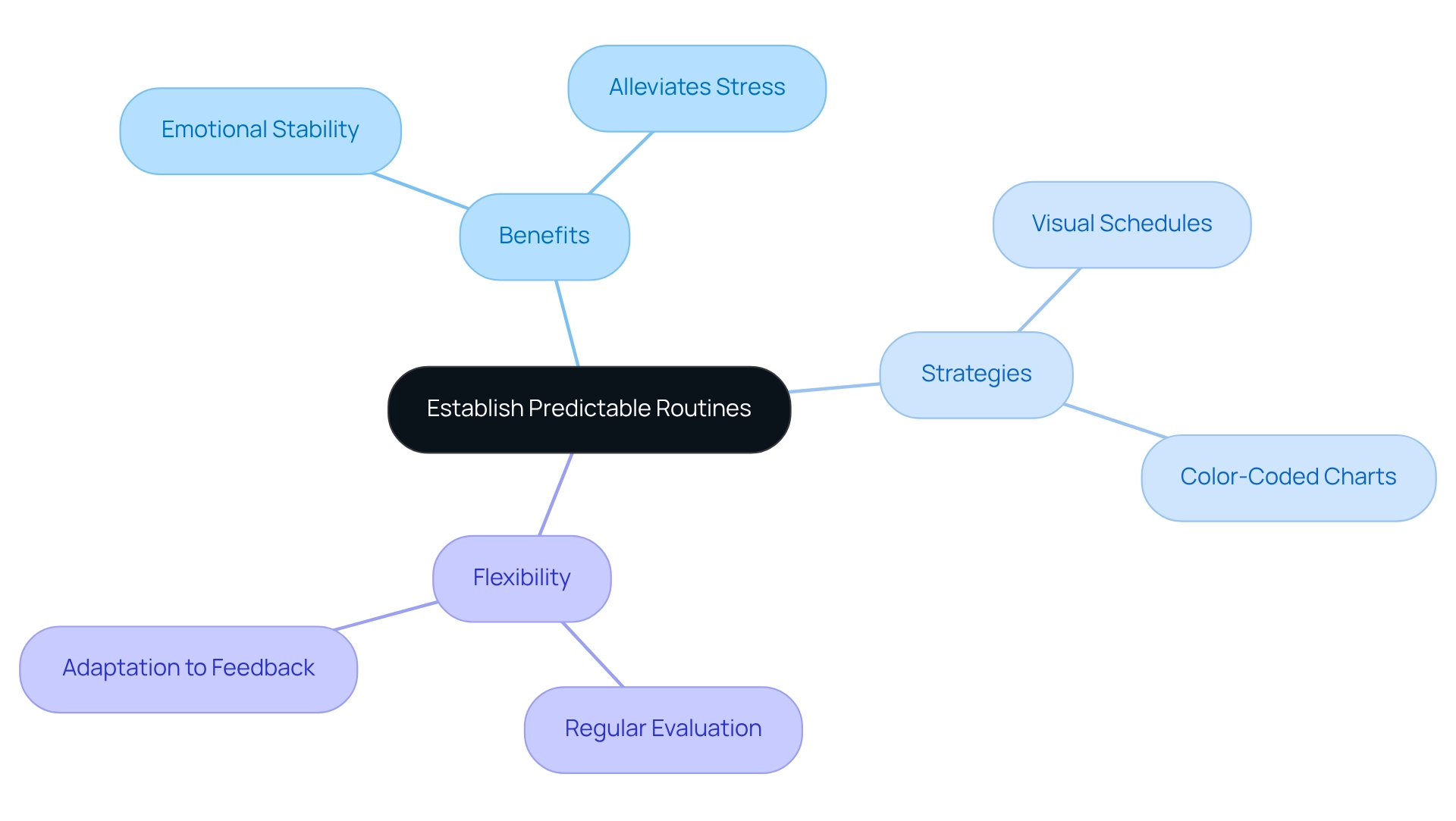
Incorporate Mindfulness Techniques: Fostering Emotional Awareness in Autism
Incorporating mindfulness methods into everyday practices can significantly enhance children's awareness of their feelings, especially for those with autism. Imagine a young individual taking a moment for deep breathing exercises or engaging in guided imagery—these activities help them focus on the present moment, fostering a greater understanding of their emotions. Research shows that mindfulness can greatly reduce anxiety and improve emotional management. It equips children with the tools to respond thoughtfully to their feelings rather than reacting impulsively.
For instance, the MYmind program revealed that participants experienced remarkable improvements in managing their emotions. These improvements were linked to the eight key change processes identified in a qualitative analysis, highlighting the effectiveness of mindfulness techniques. Regular engagement in mindfulness practices not only aids in immediate autism emotional regulation but also contributes to long-term emotional well-being.
Recent studies emphasize the need for further exploration of the mechanisms behind mindfulness-based programs. The potential of these techniques in therapeutic settings is indeed significant. Bögels et al. pointed out that interviews conducted between 1 day and 12 weeks after a booster session underscored the importance of timing when assessing the impact of mindfulness practices.
By integrating mindfulness into daily routines, parents and professionals can empower young individuals facing developmental challenges to manage their emotions more effectively. It's essential to acknowledge the typical difficulties they encounter while providing support. Have you considered how mindfulness could fit into your child's daily life? Sharing your experiences can foster a community of understanding and support.

Model Positive Self-Regulation: Influencing Emotional Responses in Children
Modeling positive self-regulation is a vital strategy for aiding individuals with autism emotional regulation and helping them learn to manage their emotions effectively. Caregivers play a crucial role in this process by demonstrating appropriate responses to stress and frustration, which equips children with essential coping mechanisms for challenging situations. For example, when faced with a difficult moment, caregivers can share their emotions and explain how they regain composure, whether through deep breaths or taking a moment to regroup. This practice not only showcases effective self-regulation techniques but also reinforces the idea that autism emotional regulation is a learned behavior.
Research indicates that children who observe their caregivers practicing self-control are more likely to adopt similar strategies, thus improving their autism emotional regulation and emotional responses. A study on the development of behavioral self-regulation highlighted varying growth trajectories among youth, illustrating the differences in how self-regulation is acquired. Some children experience early gains, while others may show progress at a later stage, underscoring the need for tailored approaches.
By consistently modeling positive self-regulation, caregivers can profoundly influence their children's development, nurturing resilience and adaptability in the face of challenges. As Bronson points out, self-regulation is a significant developmental milestone, emphasizing the essential role caregivers play in this journey. Together, let’s create an environment where our children can thrive emotionally and learn the skills they need to navigate their world.
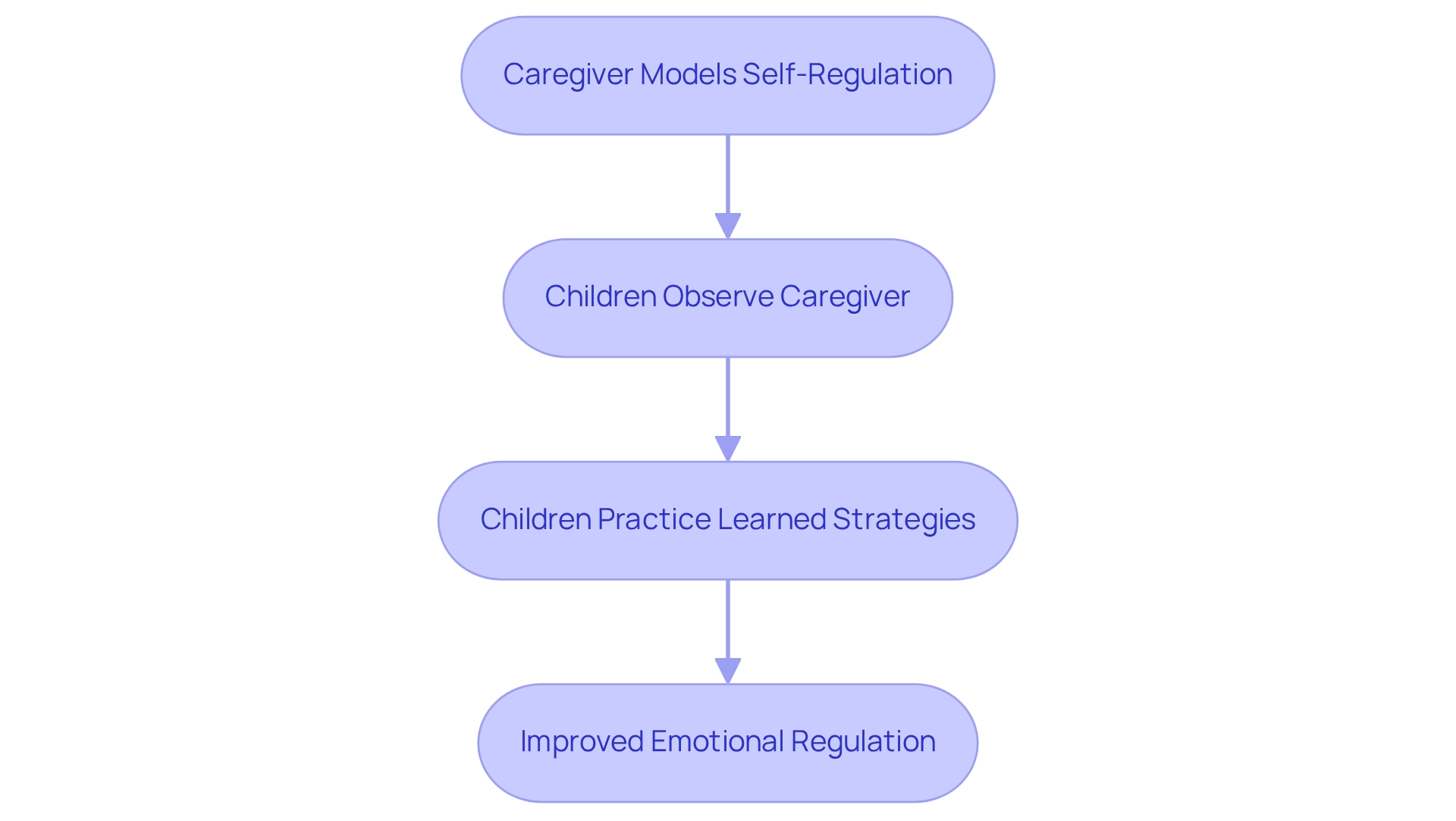
Utilize Sensory Processing Strategies: Supporting Emotional Regulation in Autism
Understanding the role of sensory processing techniques is vital for nurturing autism emotional regulation in children. By recognizing sensory triggers—like loud noises, bright lights, or particular textures—caregivers can craft a more accommodating environment that caters to each child's unique needs. One effective strategy is to implement sensory breaks, which have demonstrated positive outcomes in therapy. Additionally, utilizing tools such as noise-canceling headphones, weighted blankets, or fidget toys can provide comfort and enhance focus.
Research shows that addressing sensory needs can significantly reduce the likelihood of outbursts. A study underscores this connection, revealing a notable statistic of 12,195 = 7.66; p < 0.001, which illustrates the substantial relationship between sensory processing challenges and regulation difficulties in children with developmental disorders. Furthermore, expert insights emphasize the importance of identifying and responding to sensory triggers, empowering caregivers to offer better support.
A compelling case study titled 'Role of Parental Reports in Sensory Processing Research' highlights the invaluable contributions of parental observations in understanding sensory-related behaviors. This suggests that caregivers' insights are crucial for tailoring effective interventions. Moreover, Lane's quote regarding the need for deeper exploration of sensory subtypes, especially concerning taste and smell sensitivity, reveals the intricacies of sensory processing issues.
By concentrating on sensory processing techniques, caregivers can enhance autism emotional regulation and cultivate a more supportive atmosphere for children with developmental disorders. Together, we can create an environment where every child feels understood and valued.

Teach Self-Soothing Strategies: Essential Skills for Emotional Management
Teaching self-soothing techniques is vital for helping children with autism manage their emotions effectively. Imagine a child feeling overwhelmed; methods like deep breathing, counting to ten, or using calming visuals can provide them with essential tools to find comfort during distressing moments. As caregivers, you can encourage your child to practice these techniques regularly, reinforcing their use in challenging situations.
Moreover, utilizing first-then statements can significantly reduce meltdowns associated with emotional dysregulation. This structured approach offers a clear pathway for managing feelings, making it easier for your child to navigate their emotions. As O. Ivar Lovaas wisely stated, 'If they can't learn the way we instruct, we instruct the way they learn.' This highlights the importance of adapting our teaching methods to meet the unique needs of individuals with developmental differences.
Over time, your child will become more adept at self-soothing, leading to improved emotional regulation and overall well-being. Remember, every small step you take together is a step towards greater emotional resilience.
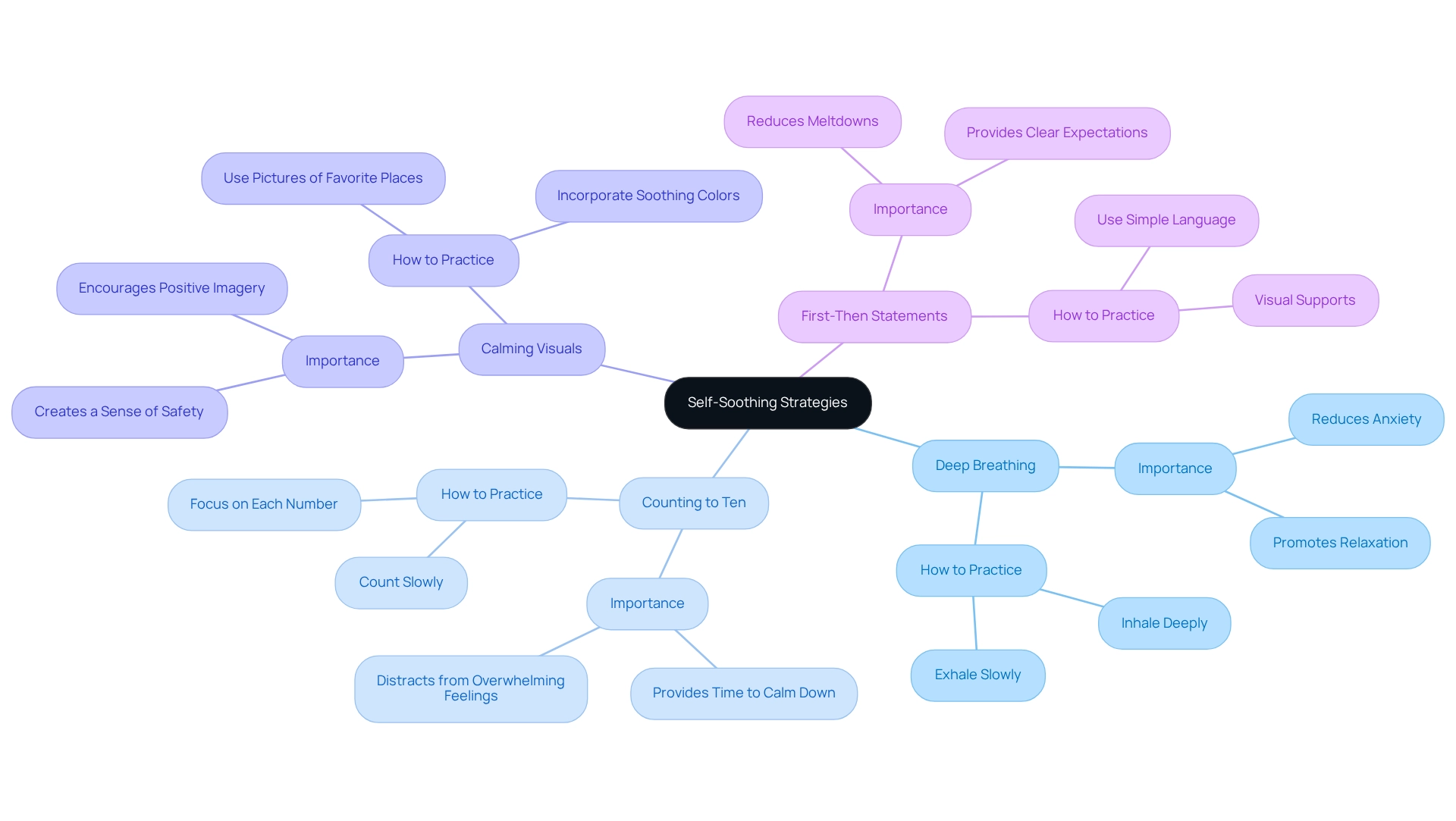
Recognize Emotional Triggers: Understanding Emotional Dysregulation in Autism
Identifying emotional stimuli is essential for effectively managing emotional dysregulation in children with developmental disorders. As caregivers, it's important to closely observe behavioral patterns to pinpoint specific situations or stimuli that may lead to outbursts. Research shows that enhancing strategies for autism emotional regulation can greatly improve overall functioning in children with autism spectrum disorders. In fact, studies indicate that individuals who can recognize and manage their triggers experience a 30% increase in adaptive functioning.
By identifying these triggers, caregivers can take proactive steps, such as preparing their child for transitions or providing calming tools in advance. This proactive approach not only mitigates the effects of dysregulation but also fosters a supportive environment conducive to autism emotional regulation.
Moreover, case studies reveal that groups that prioritize psychological safety—characterized by trust and collaboration—enhance problem-solving abilities. This principle is vital in family dynamics, where creating a psychologically safe space allows young individuals to express their feelings openly, promoting personal growth.
As Carl Jung wisely noted, "Knowing your own darkness is the best method for dealing with the darkness of others." Ultimately, this awareness empowers caregivers to nurture an environment that encourages overall well-being.
To implement these strategies, caregivers can start by keeping a daily log to monitor their child's reactions and identify trends, which can guide proactive measures.
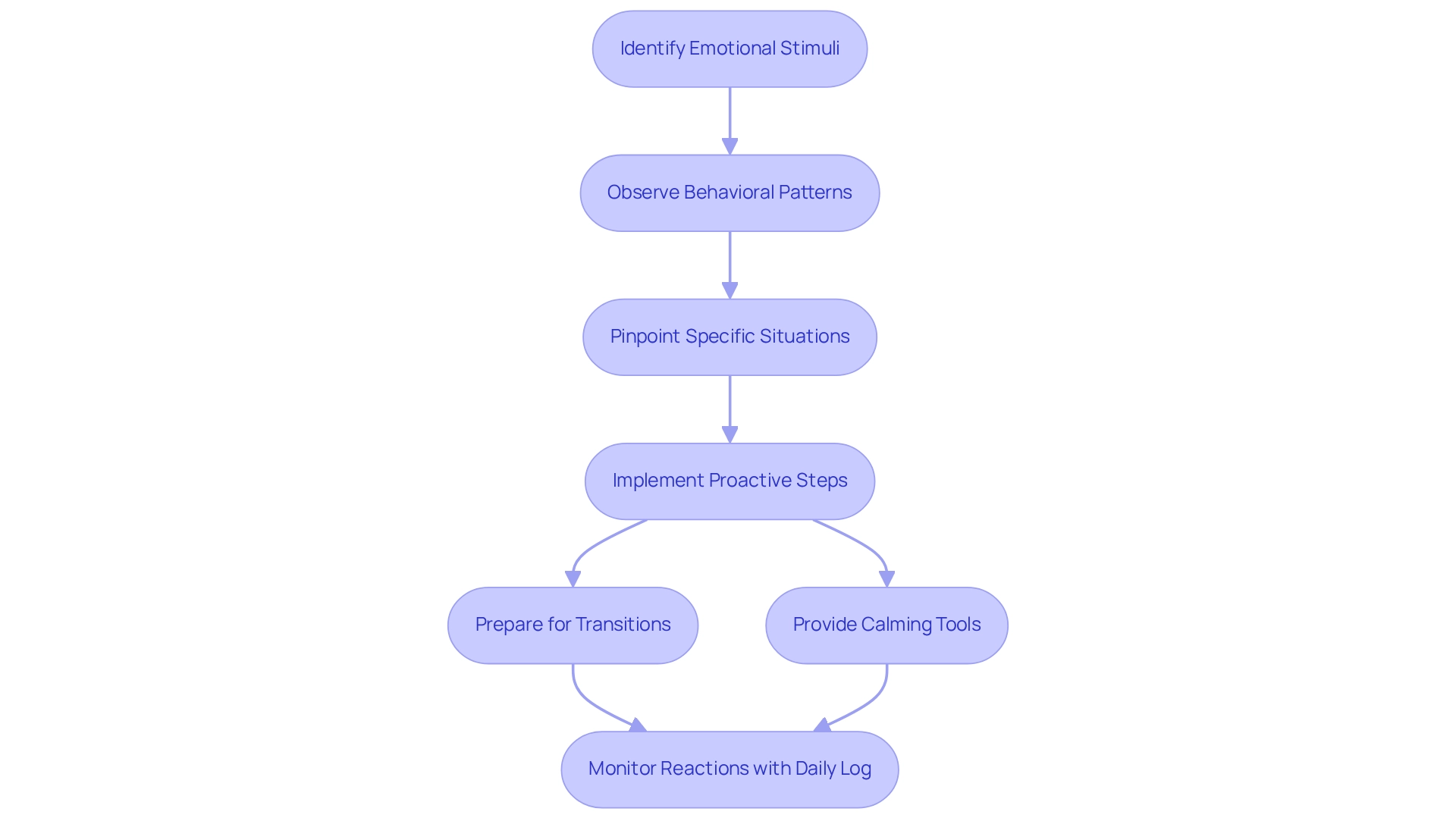
Collaborate with Professionals: Enhancing Support for Emotional Regulation
Cooperation among specialists—such as behavior analysts, therapists, and educators—is vital for enhancing regulation support in youth with autism. These dedicated experts provide customized strategies and interventions tailored to each individual's unique challenges and strengths. It is essential to advocate for comprehensive professional education and policies that foster collaborative frameworks, ensuring that all professionals are equipped to work together effectively.
Consistent interaction among caregivers and professionals is crucial. Research shows that clear communication techniques significantly enhance agreement on client objectives and progress, leading to more effective regulation outcomes. However, a notable gap exists in training for Board Certified Behavior Analysts (BCBAs) regarding interprofessional collaboration, with 67% reporting no formal training in this area. This lack of training can hinder productive collaboration, negatively impacting the psychological growth of individuals with developmental disorders.
Addressing this gap is vital, as efficient collaboration is foundational to successful autism care, ultimately supporting the development of the individual. Moreover, with over 1,000 job vacancies for ABA therapists in states like Arizona and Colorado, the pressing need for qualified professionals underscores the importance of teamwork in meeting the needs of young people requiring regulation assistance.
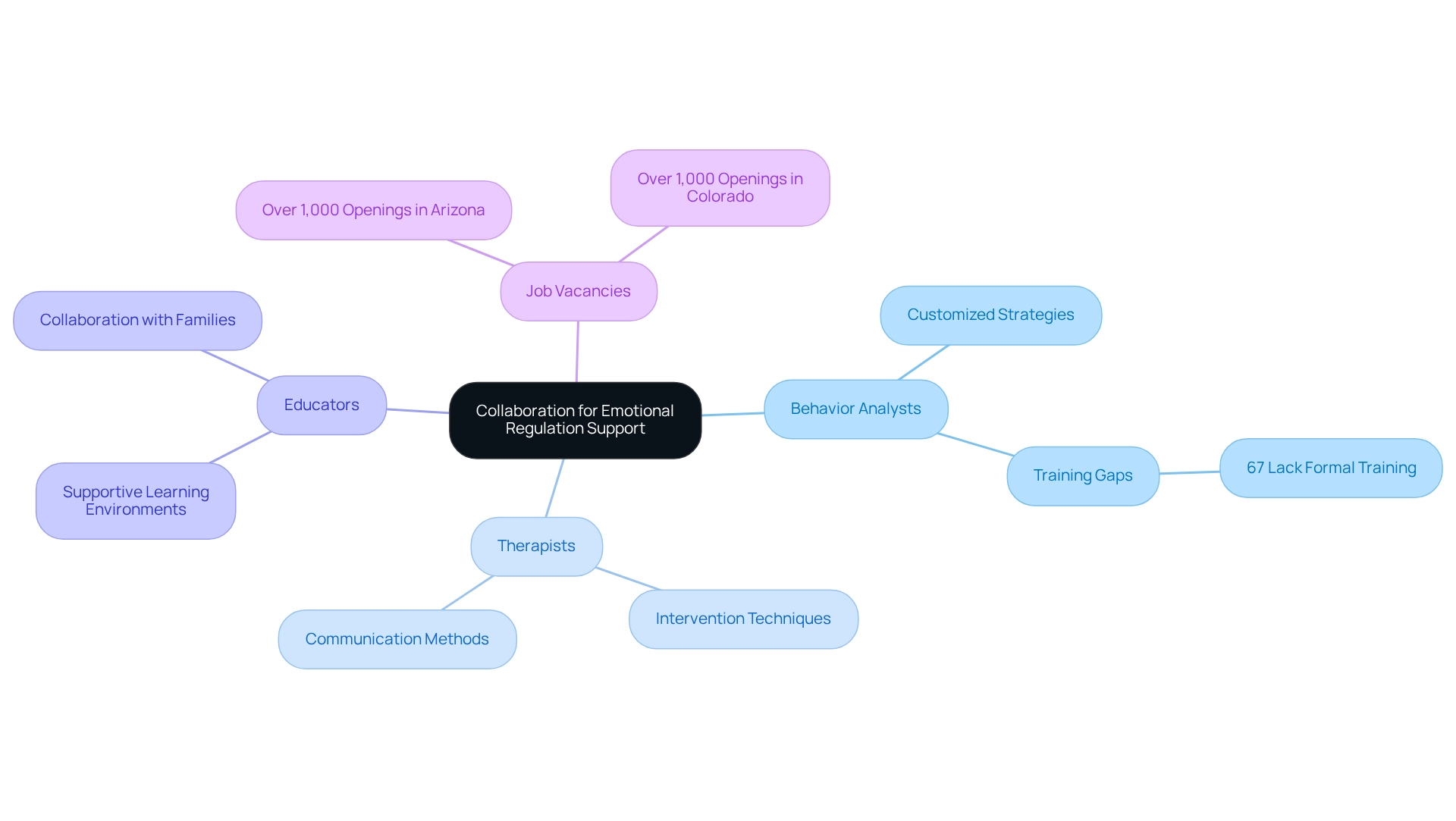
Assess and Adapt Strategies: Tailoring Emotional Regulation Techniques for Autism
Ongoing evaluation and adjustment of emotional management techniques are crucial for ensuring their effectiveness as young individuals grow and change. Caregivers are encouraged to regularly assess a young person's progress, making necessary adjustments to techniques based on their evolving needs. This might involve introducing new strategies, modifying existing ones, or seeking additional professional support.
Research indicates that youngsters facing communication challenges experience significant benefits when augmentative and alternative communication techniques are introduced early. This highlights the importance of timely interventions. Moreover, studies show that longer treatment durations lead to more pronounced gains in various skills, reinforcing the necessity for continuous assessment.
By remaining adaptable and attentive to a young person's development, caregivers can create a more effective emotional regulation framework. It's important to recognize that socioeconomic factors and access to resources significantly influence the identification and diagnosis of individuals with ASD. This further underscores the need for tailored strategies that respond to each child's unique circumstances. As caregivers, your commitment to understanding and supporting your child's journey is invaluable, and together, we can foster an environment that nurtures growth and emotional well-being.

Conclusion
Implementing effective emotional regulation strategies is essential for enhancing the well-being of children with autism. By teaching children to identify their emotions, establishing predictable routines, and incorporating mindfulness techniques, caregivers can significantly improve emotional stability and resilience. These approaches not only help children articulate their feelings but also foster an environment conducive to emotional growth.
Moreover, modeling positive self-regulation and utilizing sensory processing strategies empower children to manage their emotions more effectively. Recognizing emotional triggers and teaching self-soothing techniques provide caregivers with essential tools that promote emotional management. Collaborating with professionals further enhances this support, ensuring tailored interventions address each child's unique needs.
Ultimately, the journey towards improved emotional regulation for children with autism requires a multifaceted approach that adapts to individual circumstances. By continuously assessing and adapting strategies, caregivers can unlock the full potential of every child on the spectrum, fostering their emotional well-being and enhancing their quality of life. Together, through understanding, collaboration, and commitment, a brighter future awaits these children as they learn to navigate their emotions with confidence and resilience.
Frequently Asked Questions
What is ASD Media's mission?
ASD Media is dedicated to advancing the application of ABA therapy and providing resources aimed at enhancing autism emotional regulation for youth with developmental disorders.
How does ASD Media support parents and professionals?
ASD Media offers valuable insights, effective approaches, and a supportive community to help parents and professionals navigate the complexities of autism emotional regulation.
What financial challenges do parents face regarding therapeutic services?
The average cost of therapeutic behavioral services in the U.S. is $175.44, which can pose financial challenges for parents seeking support.
How can I stay informed about resources for youth with ADHD?
By signing up for ASD Media's newsletter, you can receive updates on the latest news and resources specifically designed to support mental health in youth with ADHD.
What issues related to bullying does ASD Media address?
ASD Media recognizes that individuals on the autism spectrum are often vulnerable to bullying and provides resources that promote community initiatives to enhance autism emotional regulation techniques.
Why is community support important for individuals with ASD?
Community support and collaboration are essential for unlocking the potential of youth with ASD, especially in diverse communities facing disparities in resource access.
What is a key strategy for improving emotional regulation in children with autism?
Teaching children to recognize their feelings using visual aids, such as emotion charts and flashcards, is a crucial strategy for improving mood regulation.
How do engaging activities benefit emotional identification in children?
Activities like storytelling and role-playing promote discussions about feelings, enhancing children's understanding and application of emotional concepts.
What is the significance of creating predictable routines for children with autism?
Consistent routines foster a sense of safety and alleviate stress, which is vital for autism emotional regulation and emotional stability.
How can parents implement predictable routines?
Parents can create visual schedules that outline daily activities, helping children anticipate transitions and prepare for changes.
What should parents keep in mind regarding routines for their children?
Routines should be assessed and modified based on feedback and developmental changes to ensure they remain relevant and effective for the child's well-being.




